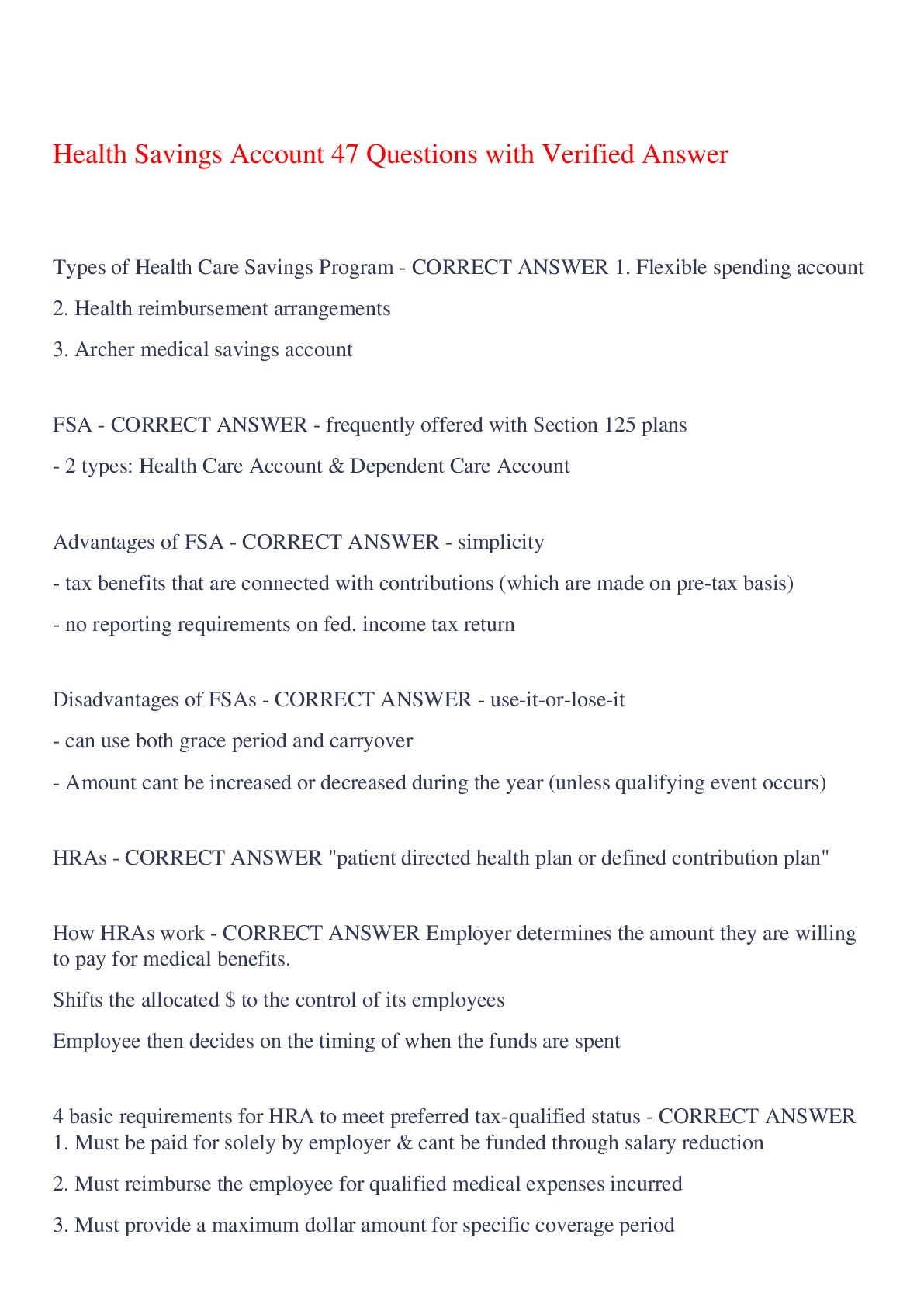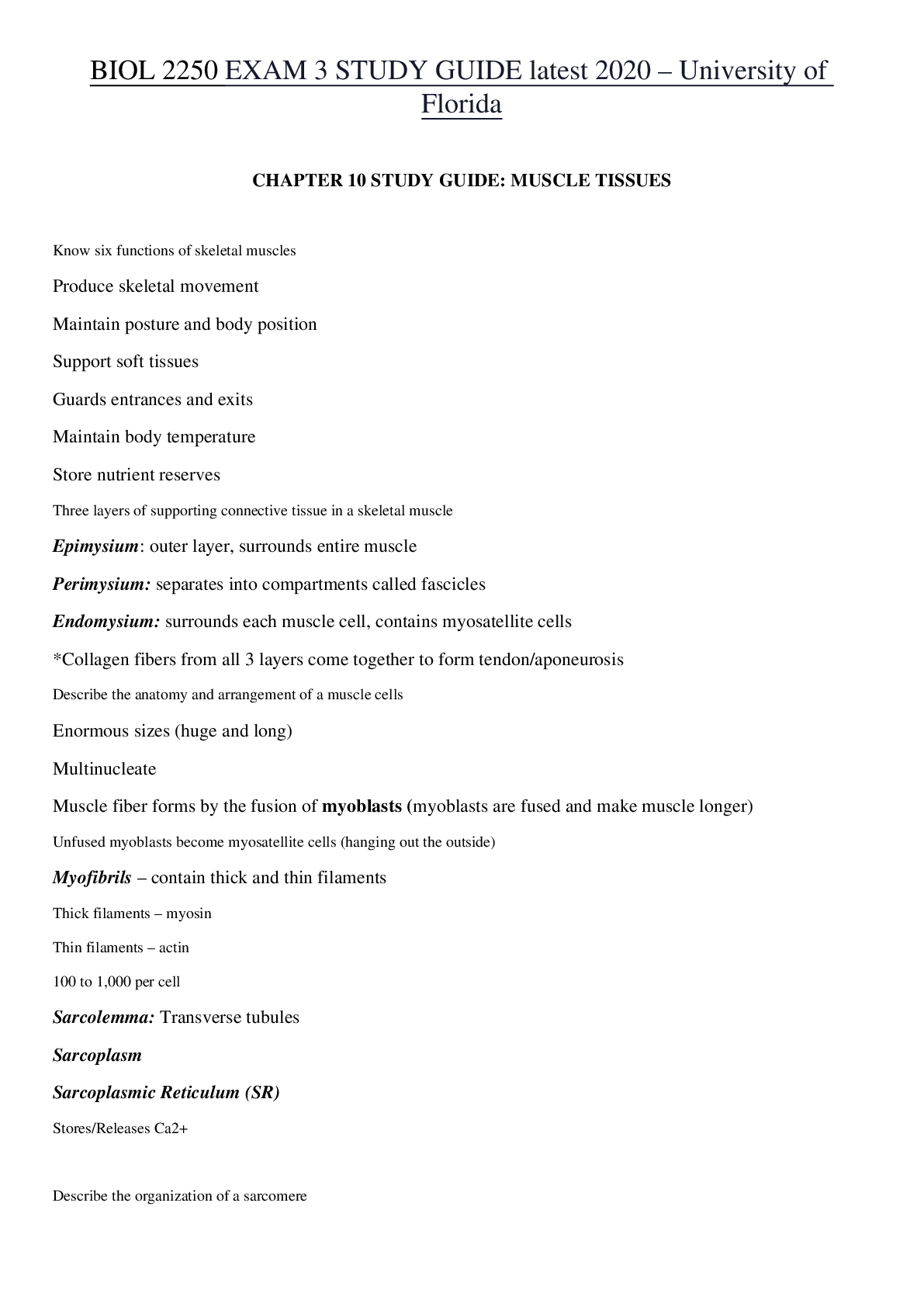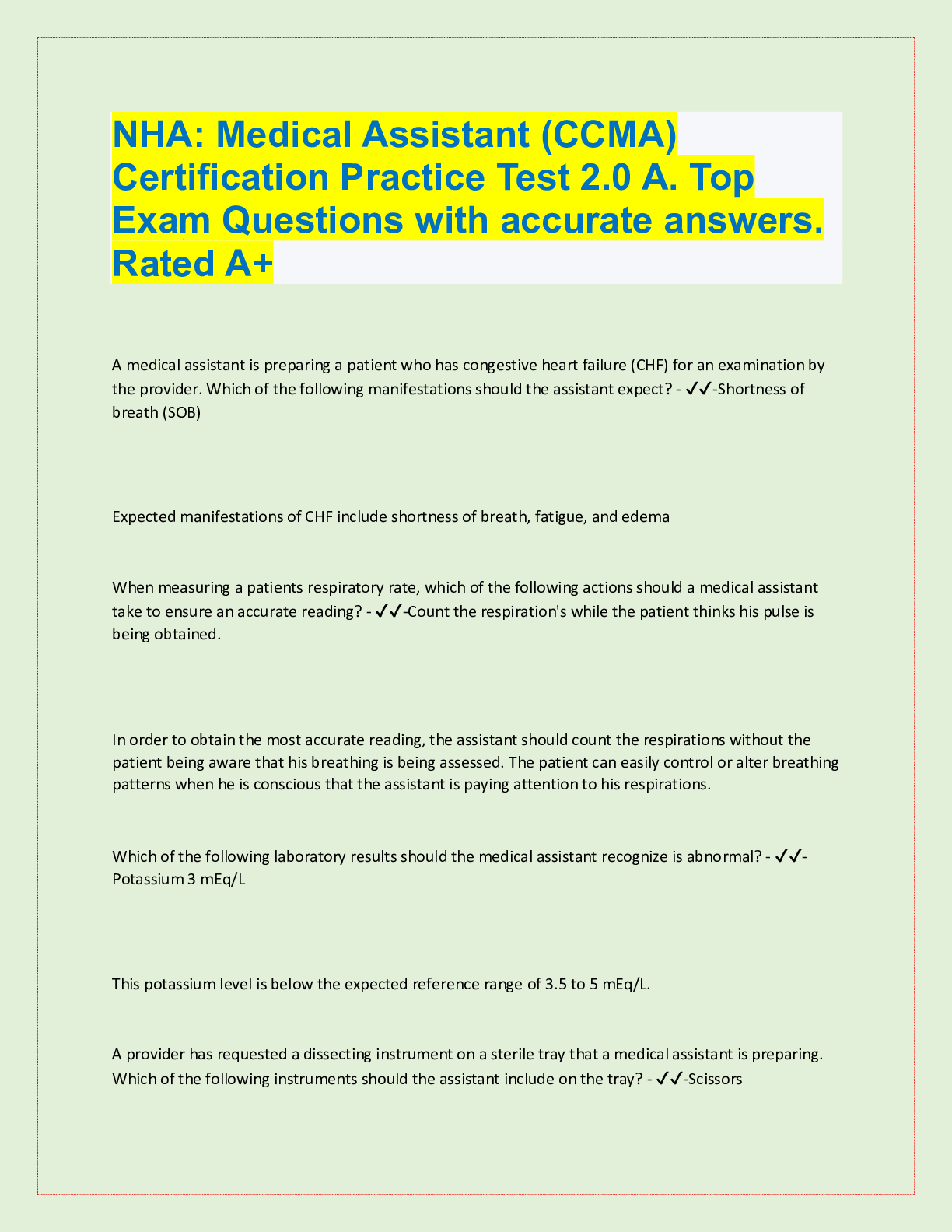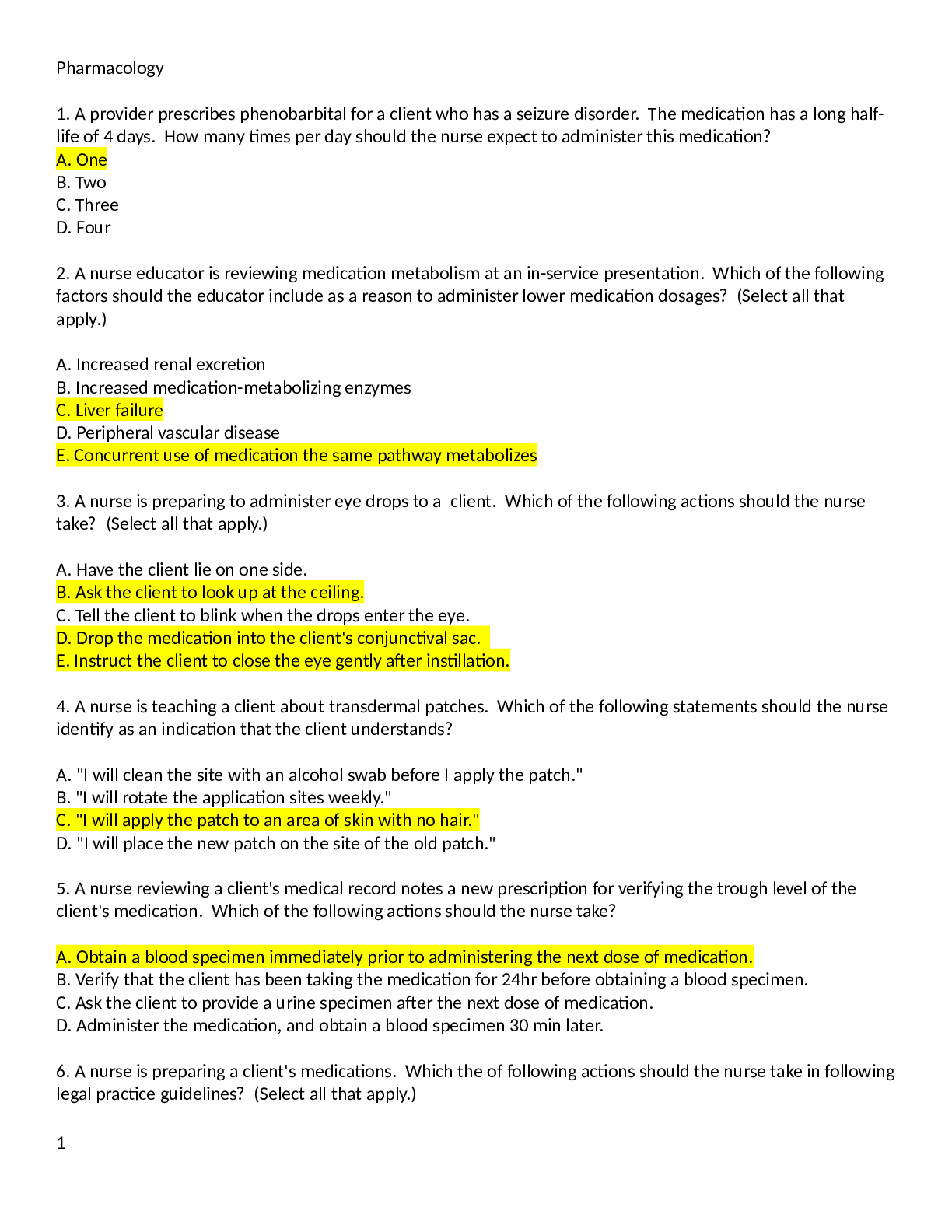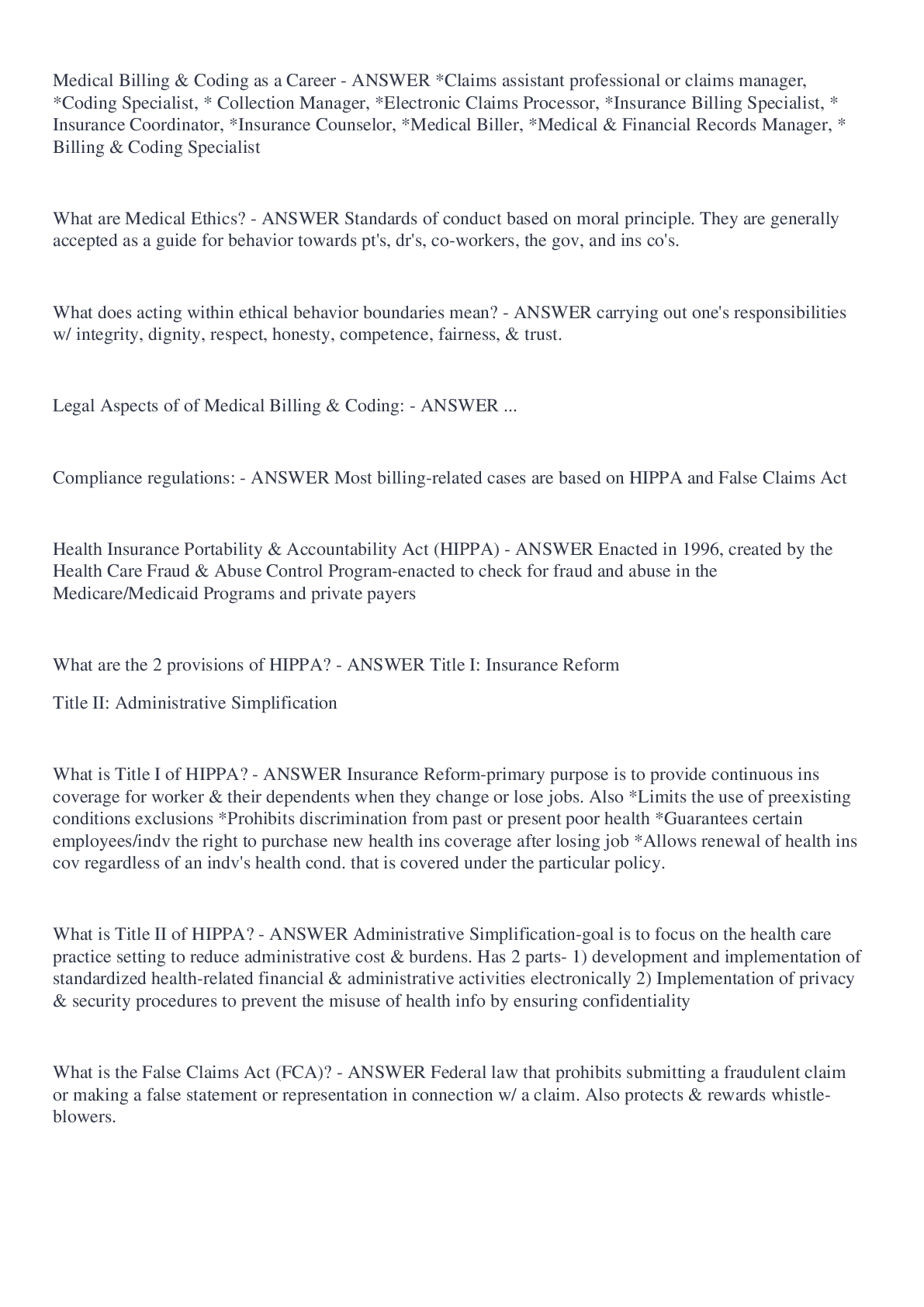NUR 370 MATERNITY TEST 1 STUDY GUIDE LATEST UPDATED 2021/2022,100% CORRECT
Document Content and Description Below
NUR 370 MATERNITY TEST 1 STUDY GUIDE LATEST UPDATED 2021/2022 Chapter 1 Health disparities - refer to differences in the health status of different groups of people. Morbidity - the unhealthy sta... te of an individual within a population. Mortality - the number of people who died within a population. HEALTHY PEOPLE 2020- 4 goals 1. Attaining high quality health care 2. Achieving health equity 3. Creating social and physical environments that promote good health for all 4. Promoting quality of life, healthy development and healthy behaviors across all life spans **failure to communicate is a major cause of errors. PROBLEMS WITH US HEALTH CARE- DELIVERY SYSTEM • Structure of the system • Reducing medical errors – 3rd leading cause of death in the US • High cost of health care – higher prices, technology, obesity. Only 21 states allow NP full practice • Limited access to care – most significant barrier is inability to pay. o Lack of transportation, child care, insurance • Health care reform – affordable care act • Accountable care organizations • Health literacy TRENDS IN FERTILITY • Low birth weight (<5 lbs 8 oz.), preterm labor (<37 weeks) • International infant mortality trends (6.1/1000) • Maternal mortality (17.3/100,000) - cardiovascular disease, non-cardio disease, unsafe abortion, infection • Maternal morbidity (obesity) - HTN, diabetes, decreased fertility, congenital abnormalities, miscarriage, fetal death EVIDENCE BASED PRACTICE- providing care based on evidence gained through research and clinical trials. AWHONN (assoc. of women’s health, obstetric and neonatal nurses, WHO (world health org.) QSEN (quality and safety education for nurses) STANDARDS OF PRACTICE AND LEGAL ISSUES- ◦ PREVENTION OF ERRORS- Joint commission list of abbreviations NOT to use: ◦ U, u (unit) ◦ IU (international unit) ◦ QD, qd, Q.D., q.d. (daily) ◦ QOD, etc. (every other day) ◦ Trailing 0 (2.0), lack of leading 0 (.2) - write 2 or 0.2 ◦ MS – can mean morphine sulfate or magnesium sulfate ◦ MSO or MgSO – same as above – write out ◦ ETHICAL ISSUES ◦ Technology ◦ Informed consent ◦ Scientific advances ◦ REPRODUCTIVE TECHNOLOGY ◦ IVF, multifetal pregnancy/reduction, menopausal women, HIV positive, rights of the embryo, cloning **consult the agency’s policies if unsure of how to perform a procedure- they are the standards of care. Chapter 3 Female anatomy Barriers to Entering the Health Care System • Financial issues – racial and socioeconomic disparities – limited finances associated with lack of access to care and delay in seeking care • Cultural issues – community focus – language, trust, disrespect, diverse groups • Constantly changing demographics – culturally sensitive and competent care, some people do not receive care bc of lack of trust • Gender issues (sexual orientation) Caring for Women Across the Life Span- menarche to menopause • Disease prevention o Adolescents – vaginitis, PAP tests, STI and pregnancy prevention, contraception o Young/middle adulthood – may use OBGYN as primary doctor, promote a healthy lifestyle o Late reproductive age – depression more likely, health maintenance screening, breast and ovarian cancer Risk Factors slides #5 &6 • Social/cultural/genetic • Socioeconomic – maternal and fetal death, risks, etc. Higher in disadvantaged populations • Substance use and abuse: o Marijuana – crosses placenta and reduces fetal oxygen o Cocaine – vasoconstriction, increase risk of miscarriage o Opiates (heroine, etc.) - women who use have a 6x higher risk for problem outcomes o Meth – irregular heartbeat, preterm birth o PCP – associated with multi drug use and neurobehavioral effects on the fetus o Alcohol – low birth weight, behavioral problems, disabilities o Cigarettes – vasoconstriction, low birth weight o Caffeine – increase risk of miscarriage. No more than 8oz of caffeine a day • Nutrition – folate/folic acid helps to prevent neural tube defects • Risk for medical/gyno conditions – PIH (pregnancy induced hypertension), endometriosis, uterine fibroids Violence Against Women - IPV- cycles, screening • Most common incidence of violence – reported 1 in 6 women o Physical/emotional, assault, isolation, controlling all aspects of the woman’s life o Cycle of violence: ▪ Stage 1: tension building ▪ Stage 2: abusive incident ▪ Stage 3: honeymoon period • Screening: o Patient should be interviewed alone o Look for inexplicable/untreated injuries (various parts of the body in different stages of healing) o Injuries that don’t match the description Laboratory and diagnostic procedures • Mammogram • STI screening • Chest x ray • Hearing • Lipid profile • Dexa scan (older woman, check hip and spine for bone density) • Drug screening, HIV, Hep B Menstrual cycle • Menarche – 1st period • Puberty – entire transition between childhood and sexually mature adult • PROSTAGLANDINS – oxygenated fatty acids classified as hormones o Produced in most organs of body (menstrual blood is a potent PG source) o Play an important role in many physiologic, pathologic and pharm reactions Cycle: occurs approx 14 days after ovulation • Endometrial cycle – 4 phases o Menstrual phase (days 1-5) o Proliferative phase (days 6-14) - day 14 = ovulation o Secretory phase – (days 15 - 28) end of ovulation to 3 days before next period (when you can get pregnant – implantation usually 7-10 days after ovulation o Ischemic phase • Hypothalamic pituitary cycle – stimulated release of GnRH and FSH. FSH stimulates development of graafian follicles and their production of estrogen • Ovarian cycle – primary follicle, graafian follicle, ovulation egg, corpus luteum, degenerating corpus luteum Chapter 4 Amenorrhea primary and secondary – absence of periods • Primary – anatomic abnormalities, endocrine disorders, PCOS, chronic disease, eating disorders, medications, drug abuse, strenuous exercise, stress • Hypogonadotropic amenorrhea – problem in central hypothalamic-pituitary axis • Secondary – 6 month or more absence (usually pregnancy) Dysmenorrhea - painful periods PMS vs PMDD – signs and symptoms and treatment PMS – cyclic symptoms occuring in luteal phase of mentrual cycle • Cluster of physical, physcologic, and behavioral symptoms • 30-80% of women experience symptoms • Treatment – diet, exercise, herbal therapies PMDD – extreme form of PMS • Last 7-10 days of menstrual cycle • Emphasis on mood • Affects 3-8% of women • Treatment similar to PMS but may warrant counseling, medication, hypnosis, acupuncture Endometriosis - growth of endometrial lining outside of the uterus • Painful periods and pain during sex • FDA approved drug for treatment – Orlissa 150-200mg or surgical intervention STI’s – Bacterial, viral /S&S, treatments – can be prevented and cured • Bacterial – o Chlamydia ▪ S/S - silent and highly destructive – screen asymptomatic and pregnant women ▪ Treatment – drug therapy w Azithromycin 1g once, doxycycline o Gonorrhea (culture) ▪ Oldest communicable disease – exclusively by sexual contact ▪ Women asyptomatic ▪ Treatment – antibiotics Ceftriaxone 125 mg once, Doxycycline, azithromycin *drug resistant strains on the rise* o Syphilis ▪ S/S - primary red painless lesion 5-90 days ▪ Secondary – 6 weeks – 6 months ▪ Management – penicillin G 2.4 million units once IM --> if allergic, tetracycline, doxy, or ceftriaxone o pelvic inflammatory disease ▪ S/S - acute: super painful, subacute: dull, cramping, intermittent pain, chronic: constant pain ▪ Treatment – prevention counseling, bedrest, oral/parenteral therapy, education • Viral – can be treated o herpes simplex 1 or 2 ▪ S/S - multiple lesions, fever, chills, malaise, severe dysuria ▪ 1 – transmitted nonsexually ▪ 2 – transmitted sexually ▪ Prevention is critical ▪ Acyclovir 400mg orally tid for 7-10 days, valacyclovir, famciclovir, keep lesions dry, topical lidocaine o HPV, ▪ More than 100 strains – 14 are cancer causing, gardasil targets 4 of those strains ▪ Most prevalent STI in ambulatory setting – genital warts ▪ Symptoms – irritating vaginal discharge w itching, post sex bleeding ▪ Screening – history, pap smear ▪ Management: TCA trichloroacetic acid, laser, cryotherapy. Nothing has been shown to eradicate o hepatitis A – contaminated food, B – sexual – most threatening to fetus and neonate, C – blood borne infection, moms who inject drugs, o HIV ▪ Routine voluntary lab testing o Zika Vaginal infections • Vaginitis – infection caused by microorganism (abnormal discharge) • Bacterial vaginosis – high concentration of anaerobic bacteria o Associated with preterm labor and birth o Findings – profuse, thin, grayish/white discharge with fishy odor • Candidiasis (yeast infection) – thick, clumpy, odorless discharge. Screen w physical exam and vaginal pH, OTC management • Trichomoniasis – wet slide diagnosis o S/S - only 30% develop any, males asymptomatic. Male partners need to be treated o Pregnant women may experience low birth weight or preterm infant Group B strep – normal flora in non-pregnant women • Associated w poor pregnancy outcomes • Screen at 35-37 weeks to decrease risk Chapter 5 Infertility- diagnosis for couples who have not achieved pregnancy after 1 year of regular, unprotected intercourse when the women is less than 35 yrs or after 6 months when the women is older than 35. Factors Associated with Infertility slide 5 • Ovarian factors: o Developmental abnormal o Anovulation o Medications • Tubal and peritoneal factors: o Developmental abnormal tubes o Blocked tubes o tubal adhesions o Endometriosis • Uterine factors: o Anomalies o Fibroid tumors o Asherman’s syndrome • Vaginal/cervical factors: o Infections o Cervical mucus inadequate o Development of sperm antibodies • Other factors: o Nutritional deficiencies o Obesity o Thyroid dysfunction Test or examination – for female infertility • Evaluation of the anatomy • Detection of ovulation • Hormone analysis • Ultrasonography • Endometrial biopsy • Hysterosalpingography – look for tubal blockages • laparoscopy male infertility- semen analysis Assisted reproductive therapies (Table 5-3) • IVF – combines sperm and egg outside of the body, placed into the uterus • Gamete intrafallopian transfer – eggs are removed and placed in the fallopian tube along with man’s sperm • Zygote intrafallopian transfer – fertilized egg placed into the fallopian tube • Ovum transfer – mature egg collection • Therapeutic donor insemination – sperm donor • Embryo hosting – adopt an embryo • Assisted embryo hatching – weaken outside of embryo to help it stick Contraception- care management • Nearly half of all US pregnancies are unplanned Methods of Contraception ****- identify best options for client • Safe, readily available, economical, acceptable, and simple to use • Must meet personal, social, cultural and interpersonal needs • Coitus interruptus – 27% failure rate • FAM method – 24% failure rate • Progestine-only contraceptive – for lactating women • Plan B – high dose of levonorgestrel – take within 72 hours, delays ovulation • IUD – increased risk of pelvic inflammatory disease and uterine perforation • Sterilization – BTL – bilateral tubal litigation (uterine tubes severed and tied) Abortion Slide 23 • Purposeful termination before 20 weeks o Elective or therapeutic o First trimester – less than 9 weeks ▪ Surgical – vacuum or suction curettage ▪ Medical – methotrexate and misoprostol, mifepristone and misoprostol o second trimester – 9-20 weeks ▪ Dilation and evacuation, cervical prep with prostaglandins Chapter 6 Fetal heart rate: 110-160! GI system mature by 36 weeks Genes and chromosomes • Chromosomes – DNA that forms threadlike strands • Genes – coded information, determines individual’s unique characteristics • Homologous – chromosomes have the same number and arrangement of genes • Alleles – genes at corresponding loci on hom. Chromosomes that code for diff variations of the same trait • Homozygous – person has 2 copies of the same allele • Heterozygous – person has 2 different alleles • Genotype – individual's genetic makeup • Karotype – number form and size of person’s chromosomes Chromosomal abnormalities – can occur during miosis or mitosis • Autosomal abnormalities – abnormal chromosome number (downs syndrome, trisomy 18) Unifactorial/multifactorial transmission • Unifactorial – single gene controlling trait/disorder o Autosomal dominant inheritance – only need one copy for expression (marfan, dwarfism) • Multifactorial– most common, combo of environmental and genetic factors (2 or more things affecting growth of fetus) • Genetic counseling – maternal serum marker screening at 15-21 weeks – blood test to determine risk of carrying baby with genetic disease o Amniotic fluid: too much = hydramnios, too little = olygohydramnios Cell division and conception • Meiosis – cell division that creates sperm and egg cells • Mitosis – cell duplicates all of its contents Twins- monozygotic/ dizygotic Genetic and nongenetic factors that influence fetal development • Genetic - • Nongenetic – nutrition, drugs/chemicals/infection/radiation/maternal conditions Chapter 7 Pregnancy tests- hormones, higher, lower results • Human chorionic gonadotropin (hCG) is earliest biochemical marker of pregnancy • Pregnancy test – based on levels of hCG. Detected in urine 7-10 days after ovulation • Higher levels – abnormal gestation or twins • Lower levels – miscarriage • ELISA testing – most popular pregnancy test Signs of pregnancy • Presumptive – changes felt by the woman (no period, nausea, breast enlargement, fatigue, constipation, food aversions, etc.) • Probable – changes felt by an examiner (soft cervix, abdominal bloating/enlargement, mild uterine cramping with no bleeding, increased pigmentation) • Positive – signs attributed only to presence of the fetus (fetal heartbeat, ultrasound, positive hCG) Gravida-Term- Preterm- Abortion- Living • Gravida – number of pregnancies • Term – pregnancy 37 weeks or greater • Preterm – pregnancy 20-36 weeks 6 days • Abortion – loss of pregnancy before 20 weeks • Living – living children Parity • Number of pregnancies in which fetus or fetuses have reached viability, not affected by whether the fetus is born alive or stillborn • Gravity = pregnancy, parity = 20 weeks or more Pregnancy changes- quickening, Chadwick’s sign, Goodell’s sign • Quickening – flutter of fetus – 14-18 weeks • Goodell's sign – softening of cervix • Chadwick’s - 6-8 weeks blueish/violet color of the cervix, leukorrheacopious discharge Any tables Body changes due to pregnancy • Uterus – above symphysis pubis at 12-14 weeks, umbullicus 22-24 weeks Supine hypotensive syndrome • Woman lies on her back and BP drops 30mm Hg after 5 mins, reduce cardiac output and woman feels faint Chapter 8 Pregnancy- length and trimesters • 9 calendar months, 10 lunar months (280 days) • First: weeks 1-13 • Second: weeks 14-26 • Third: weeks 27-40 Nägele rule (Box 8.1 pg. 167) • Determine day of last menstrual period, subtract 3 months, add 7 days plus 1 year o Ex. Last date of period was july 7th - 3 months = April 7th + 7 days = April 14th 2021 o Most women give birth 7 days before or after Maternal and paternal adaptation • Announcement phase – accept pregnancy • Moratorium – adjust reality • Focusing – last trimester, active involvement Barriers obtaining prenatal care • Poverty, no health insurance Maternal and fetal assessment Supine hypotention S&S pallor dizziness, faintness, breathlessness Tachycardia Nausea Clammy, sweating Sibling and grandparent adaptation Chapter 9 Folic acid= folate / prevention of NTD (400mcg) Foods – green veggies, cereal Factor for increased needs of pregnancy • Uterine-placental fetal unit • Increased maternal blood volume • Mammary development • Metabolic needs Weight gain- Normal weight 18.5- 24.9- weight gain 25-35lbs Pica Folate, calcium, iron Prevent preeclampsia (high BP with proteinuria) with an adequate diet [Show More]
Last updated: 1 year ago
Preview 1 out of 15 pages
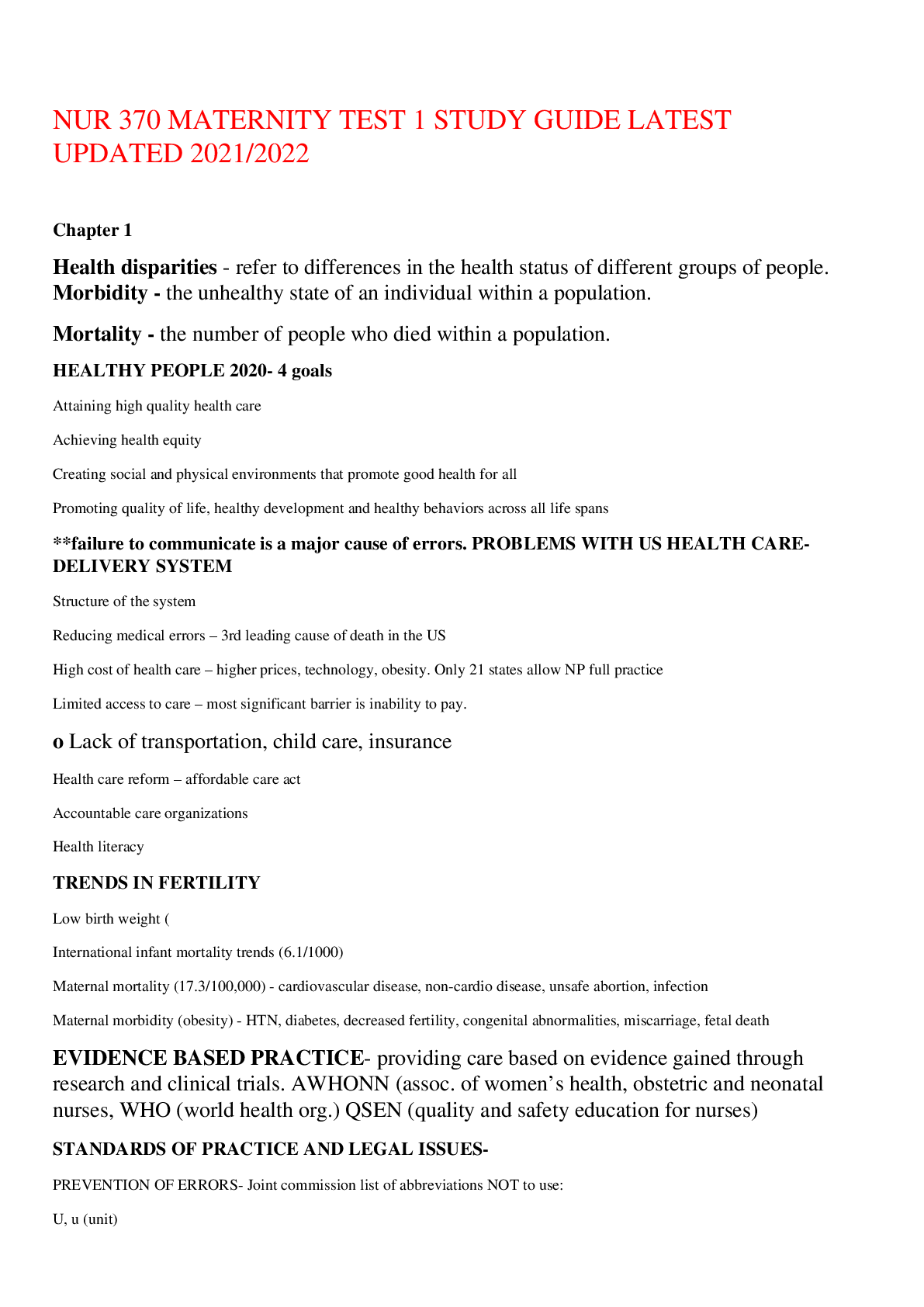
Reviews( 0 )
Document information
Connected school, study & course
About the document
Uploaded On
Apr 17, 2022
Number of pages
15
Written in
Additional information
This document has been written for:
Uploaded
Apr 17, 2022
Downloads
0
Views
40














